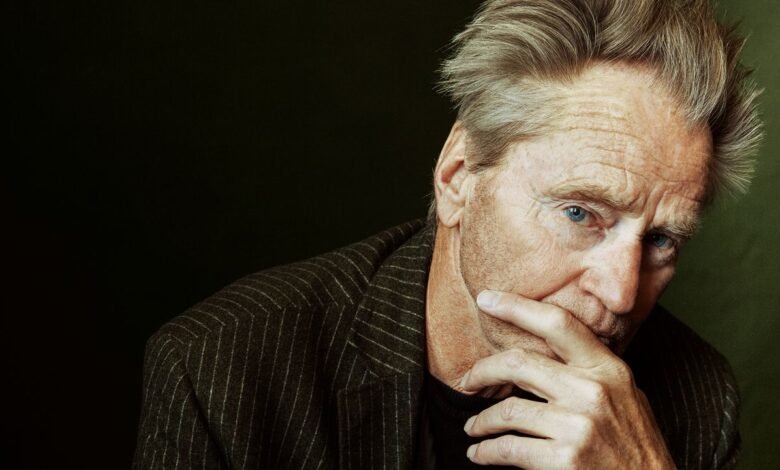Sam Shepard’s Enactments of Manhood

In the older Rogers’s case, the alcohol and the trauma worked a deep transformation; he grew paranoid about his family, and would go on furious rampages. Something about his rangy teen-age son particularly antagonized him—“Sam called Steve his nemesis,” Shepard’s mother wrote in her diary. “Sam, Sr. came to regard his only son as female,” Dowling writes, quoting Shepard’s own 1978 writing, buried in the archive at the Harry Ransom Center. His father, Shepard wrote, thought he was “not exactly a woman but of the female persuasion . . . not fruity exactly, but suspicious.” Dowling predicates his book on Shepard’s response—the masculine selves he fashioned around those early wounds.
Dowling is hardly the first to write that Shepard struggled with his inextricable antagonism for his father. You find this Oedipal current in countless profiles and in the criticism; you find it in other biographies, such as Don Shewey’s theatrically savvy “Sam Shepard,” published in 1985, and in Robert Greenfield’s juicy “True West,” from 2023. You find it most in Shepard himself—one of his last plays was “A Particle of Dread (Oedipus Variations).” Dowling’s book doesn’t stop at the men’s “silverback gorilla” fights, though, as the source of pain. He suggests by analysis and anecdote that Shepard’s conscious performance as a “man” to deny his father’s deliberate emasculation of him is the source of his tendency to shape-shift, his fundamental slipperiness.
In 1963, a job with a touring theatre company bore Steve Rogers across the continent to New York: a year later, just twenty years old, he started performing under the stage name Sam Shepard, cutting loose of old associations. In New York, as Sam, he became one of the best-regarded young playwrights of a wild, druggy, ecstatic downtown scene. My favorite parts of “Coyote” take place in the East Village of that time, when a counterculture Shepard, zooted out of his mind on various chemicals, hadn’t yet settled on the clenched jaw and thousand-yard stare of his later, dead-eyed Sam persona.
In the Village, Shepard played in bands; he hung out with his roommate Charles Mingus III and his first serious girlfriend Joyce Aaron, who was his entrée into certain echelons of the avant-garde theatre scene. Tony Barsha called Shepard’s corner of the scene “Macho Americano,” defining it as “a lot of pot, a lot of women.” Love triangles rotated like mandalas—Shepard dated and then married O-Lan Jones while they were both being directed in shows by her ex-boyfriend—and his dramatic work, such as “Icarus’s Mother” (1965) and “La Turista” (1967), reimagined the alienation of the Vietnam War period as dark games, prescient dreams, trippy picnics gone bad. Look him up on YouTube playing drums for the Holy Modal Rounders on “Rowan & Martin’s Laugh-In.” You see a loose, goofy, lissome beanpole in flares, laughing below a shaggy bob.
He may have had a “cowboy mouth,” but he was not playing the cowboy yet. That came later, after he moved back to California in 1974, in his early thirties, carrying his small family out to a ranch, where he could keep ducks and chickens and horses. For Shepard, the West was both the authentic place (meaning a life lived close to the land) and the realm of falsehood (Hollywood). These qualities were tightly bound. His film career kicked off because Terrence Malick saw him mucking out a stall and, impressed, chose him for “Days of Heaven.”
According to Dowling, Shepard knew himself to have a profoundly divided self—abrasive, hot-tempered, prone to crises of “depersonalization.” Shepard wrestled with a sensation of doubleness, this “feeling of separation between my body and ‘me,’ ” he wrote in a letter to the experimental theatre titan Joe Chaikin, a dear friend of his. Dowling considers his masculine playacting a necessary unifying armature, something powerful enough to bind together these splintering parts. And so the snake-hipped, shaggy-haired rock star in fur coats and sunglasses vanished in California. “Shepard had now, knowingly, placed all his fractured selves within a single hardened shell. For him, the identity of the cowboy was the strongest choice—manly, self-assured, tight-lipped, born to nature,” Dowling writes, and Shepard turns to his new (and lasting) costume: the “jeans, scuffed boots, Levi shirts.”
So much of Shepard’s writing was literature “à clef” that Dowling does sometimes take such accounts at their word, leaving us to ferret around in the notes section to figure out where he’s getting his (frequently incredibly personal) information. In one startling case, Dowling uses an oblique piece in Shepard’s collection “Motel Chronicles” as a source for his private feelings about the nascent love affair with Jessica Lange. It’s an amazing bit of detective work—Dowling works out that the story is dated on the day that Shepard would have been driving back from seeing Lange on a movie set in Los Angeles—though it does require us to join Shepard in eliding what is written as fiction as fact.
Shepard wrote and wrote, often writing his mind on his sleeve. His short stories are confessional; so are many of his plays, and certainly several of the screenplays. He and Patti Smith even performed “Cowboy Mouth,” as themselves, on a theatre bill that included his actual wife. (This much candor finally overwhelmed even Shepard: he bugged out after the first performance.) Want to know what it was like for him to grow up with his violent father? Watch his tribute to Eugene O’Neill, “Curse of the Starving Class,” from 1976, which dramatizes the terrifying tantrum-like explosion—his father smashed his way through a door, after Shepard’s mother locked him out—that shaped his jumpy, scalded-cat spirit. This rigorous self-exploration continued past the point that his disease cost him control of his hands. His last writing, a novella called “Spy of the First Person,” written with the assistance of his sisters and daughter, is some of his most beautiful. It narrates the feeling of being observed, from within one’s own dying body.




